I started my All-On-X journey as inexperienced as you can get.
Four years out of OMFS residency, I had yet to do a single fixed arch. On top of that I was only placing 5-10 single implants per year in a de novo private practice.
I had very little confidence with implant placement and as a result had little to no interest in implant surgery.
Burned out and disheartened with many aspects of oral surgery, I sold my half of a practice in Las Vegas and my wife and I moved to Dallas, Texas.
It was in Dallas, in the summer of 2019, that I started my AOX career at a full arch focused practice.
It was an odd turn of events and not my first choice for a job.
I was intimidated to say the least. I honestly wanted nothing to do with AOX surgery.
However, my wife, a general dentist, was convinced that I would be good at this procedure and urged me to pursue it. So, I hesitantly gave it a try.
Almost instantly I fell in love with the surgery and have done it full-time ever since.

While I have become extremely passionate about this surgery, I would be lying if I implied it’s been all sunshine and roses.
I have had some very difficult cases, some notable complications, and some very stressful situations that have made me second guess myself and my career path.
With the experience I have now, I want to help you avoid some of the stress AOX surgery can create and enjoy more of the good times. Maybe…just maybe… we can fast track you through some of your time at the School of Hard Knocks.
I have looked back over my last 1500 arches to think about what I have learned that I wish I would have known when I first started.
1. Surgical treatment planning should take 2-3 minutes…not 2-3 hours.
One of my biggest concerns when I first started doing AOX surgery full time was “How in the world will I treatment plan all these cases”?
I was used to seeing other surgeons treatment plan for up to an hour or more per case. There were phone calls, computer models, digital implants to be sized and moved. It seemed exhausting and very time consuming.
If this is you too…don’t stress out! This is not how it should be!
Accurate, precise surgical treatment planning can and should be done in 2-3 minutes per case, or less, by experienced providers.
Starting out you will take longer. And that’s totally fine! A good goal is 5-10 minutes per case. But there is simply no need to spend an hour of your time planning the surgical aspect of an AOX case.
And no… I am not being sloppy or fast. I am very, very detail oriented and precise in my planning and take immense pride in the quality of my work.
Check out my article here that will show you exactly how to treatment plan an AOX case in 2 minutes or less.
2. The single most important aspect of surgical efficiency is understanding the roles of your surgical assistants…and then allowing them to perform those roles effectively.
If you want to be able to do an arch consistently in an hour or less, you need to have great assistants, and utilize them well.
I have 2 assistants in every surgery (in addition to my anesthesia provider).
One assistant is with me chairside. Their primary roles are keeping the field free of blood, irrigating and suctioning while I’m drilling, and manipulating the Oringer retractor to help increase my field of vision during the surgery.
A second assistant is positioned to my right, where the drill is located. Their primary roles are passing instruments, loading/changing implant drills, loading and passing implants, and preparing and passing abutments.
My goal is to keep my eyes on the surgical field the whole time.
To put this in perspective, when I operate with a new team it takes me about 90 minutes to do an arch. When I operate with a team I have worked with consistently it takes 45-60 minutes to do that same arch.
That’s a huge difference and shows the tremendous value your team has in the success and efficiency of the procedure.
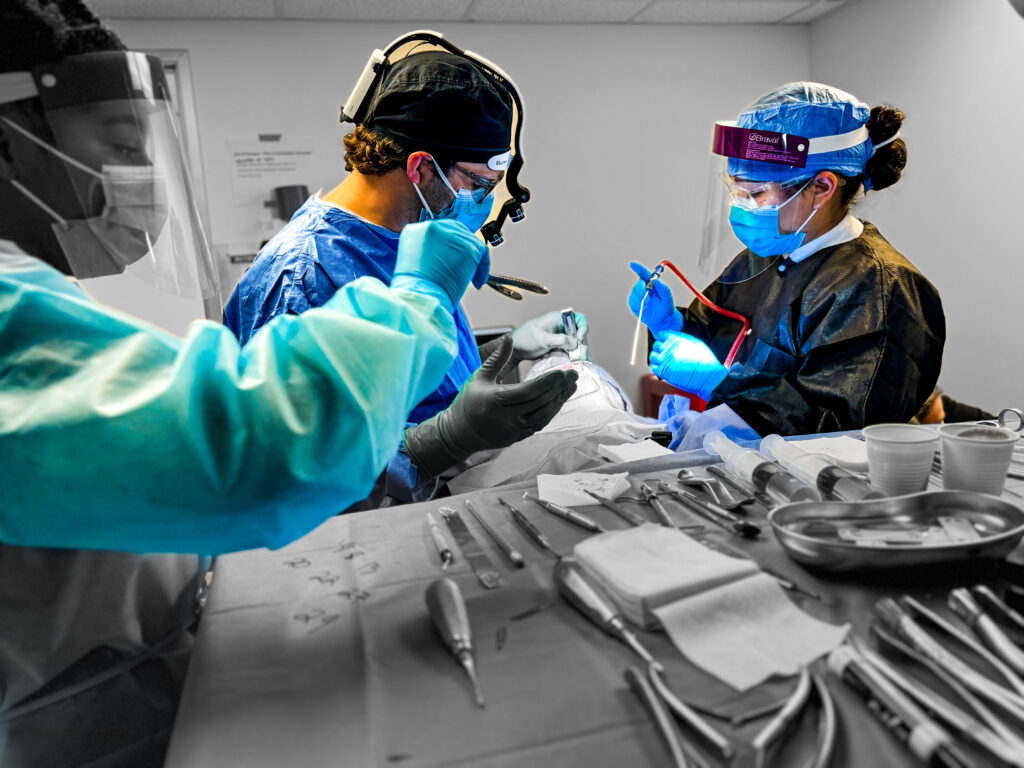
3. Teeth First – Incision Second.
I am absolutely convinced that removing teeth first, and making incision second, sets you up for the best closure (amongst other benefits)!
With the teeth out of the way first, you are able to make a much more exact, smooth incision, strategically removing the papilla in a way that will set you up for a beautiful soft tissue closure.
I will admit this is not the most common way in which surgeons operate. But if you want to be different…you can read more about this technique here.
4. My abutment angles, surgical closure, and screw access position are really all my restorative doctor ever sees.
As surgeons, we inherently focus on the “bone” and the “implants”. And we should have focus on these things.
But…I wish I would have realized earlier that the most important aspects of the surgery for my restorative colleagues, and for the referral relationship, are not the “bone” and the “implants”.
What my restorative provider really cares about (and all they really see after I’ve closed) are the following:
My Abutment Angles
Is the case restorable? And how easy or difficult will it be to do so?
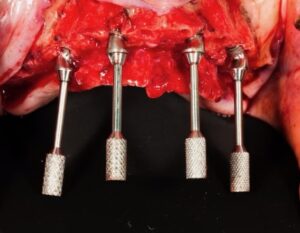
My Surgical Closure
Will the tissue be moving around and covering abutments? Or will it be laying nicely, and firmly around the abutments for an easy pick up?
If special care is not taken, this can be especially burdensome for the restorative provider on the mandible, where tissue tends to move more freely.
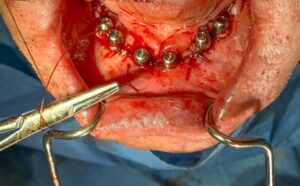
My Screw Access Position
How much, or how little, over the next decade…will they have to hear the patient complain about too much palatal or lingual prosthetic material due to less than ideal implant position?
Furthermore, how much cantilever have you left the restorative provider to deal with? An increased cantilever can lead to increased prosthetic fractures and repairs that create more work for the restorative provider.
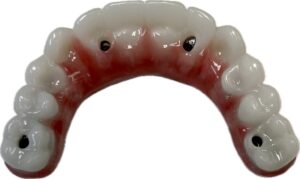
Put your emphasis on these things and you will always have referrals.
5. Zygomatic implants are not necessary the vast majority of the time.
Early on in my career I turned down a lot of cases because I thought they could only be accomplished with Zygomatic implants, and I did not yet have this skillset.
I wish I would have realized sooner that the vast majority of cases do not require zygomatic implants.
I treat ~98% of patients that walk into my office without zygomatic implants. These patients are provided an immediately loaded, full arch prosthetic without delayed loading.
- We will explore how to accomplish this in a handful of other articles covering these techniques.
While I am not against zygomatic implants, the take home message is that as a surgical provider you can have the confidence to treat the vast majority of the patients in your office without zygomatic implants, should you choose to do so.
6. Anesthesia is better when performed by a separate anesthesia provider.
I am a true believer that with AOX surgery, having both a surgical provider and an anesthesia provider working as a team, is simply the best way to safely and effectively accomplish this procedure.
I am not saying that OMFS providers should not be able to administer their own anesthesia.
However, virtually every OMFS provider I know would agree that with the complexity of these surgeries, the duration of time that anesthesia is required, and the medical complexity and comorbidities that these patients present with…it is simply a better and safer experience for both the patient and the surgeon to have a separate anesthesia provider.
I know that I enjoy AOX cases more, and perform better for my patients, when I can focus solely on the surgical aspect.
7. It’s ok to be intimidated or afraid. But move forward anyway.
I wish I would have found AOX surgery sooner! I truly love it!
The ONLY reason I didn’t start sooner…was that I was afraid. I didn’t fully understand the surgery and the prosthetic portion was very confusing to me. Despite being an OMFS, I didn’t feel that I had the training to do AOX surgery well.
While these fears were not valid. I let them hold me back. I wish I had jumped in sooner!
I have had to learn that it’s ok to be intimidated or afraid when pursuing the things that you want. You just have to keep moving forward anyway.
We can never start over in life. But we can learn from those who have come before us and benefit from their mistakes and subsequent knowledge gained. I hope this glimpse into what I wish I would have known and done earlier in my career gives you insight and wisdom into how to better shape yours.
Matthew Krieger DMD

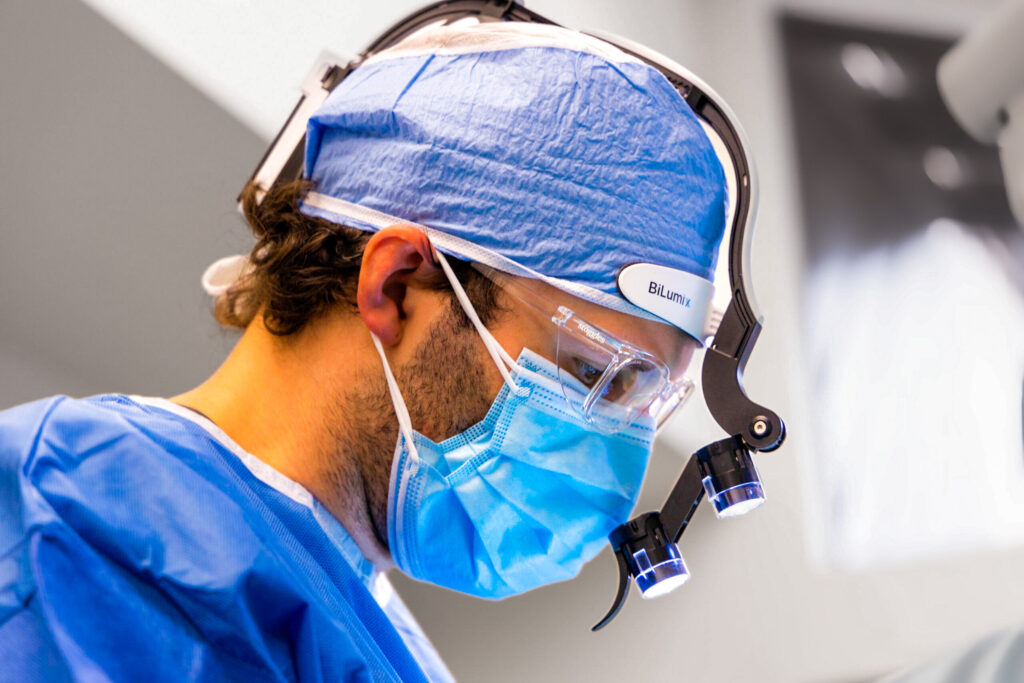
Amazing surgeon, great mentor and friend. Great job Dr. Krieger!!
Amazing job , very proud of you and thankful for you sharing your experience . Definitely will help us as dentists and better serve our patients .
Joseph Akhikar DMD
Thank you for sharing your experience. I heard about you on the Full arch podcast first. let me know if I can help in anyway.
Mehrdad Ebadi, DMD